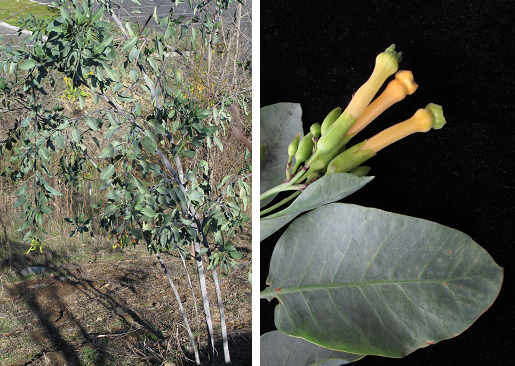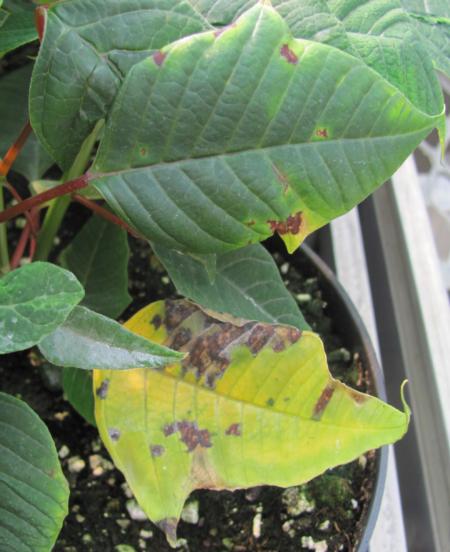DISEASE FOCUS: Weeds as a source of plant virus infections and bacterial leaf spot of poinsettia
by Deborah M. Mathews
Another common plant found in nature (especially in Southern California) that essentially grows as a weed and is listed as an invasive plant, is Nicotiana glauca or tree tobacco. It often grows along creek beds or culverts, on hillsides, along roadsides and areas where soil is disturbed and can be identified by its smooth blue-green leaves and bright yellow tube-shaped flowers (fig.1 A, B). I studied this plant during my Ph.D. research by placing 240 healthy seedlings out on the field station at UC Riverside and testing for viruses every 6 months for 2 years. By the end of the trial all surviving trees contained at least 1 to 5 different viruses, primarily TMV, CMV and Potyviruses. This shows how easily these viruses can get around in nature and that tree tobacco can act as an important perennial reservoir. Prevention and eradication of weed species within and surrounding greenhouses as well as near field crops are the best management methods.

(A) (B)
Fig. 1. (A) Growth habit of tree tobacco (Nicotiana glauca). (B) Close up leaves and flowers.
Photos by Deborah Mathews.
Bacterial Leaf Spot of Poinsettia
I’ll try to give a little equal time to something other than viruses this month: One disease that seems to have become more prevalent the last couple of years across the United States is bacterial leaf spot of poinsettia caused by Xanthomonas axonopodis pv. poinsettiicola. Spots start out on the undersides of leaves and are grayish brown in color. As the spots enlarge, they become visible on the upper side of the leaf and will be tan to brown. Eventually they become necrotic (dead spots) surrounded by a water-soaked area of lighter green or yellow (fig. 2). As many spots merge together, lesions will become angular in shape. Symptoms are similar to the leaf spots caused by the fungi Sphaceloma poinsettiae (scab=spot anthracnose) and Alternaria euphorbiicola, so a proper diagnosis should be obtained prior to control applications.

Figure 2. Leaf spots on a poinsettia plant caused by the bacterium Xanthomonas axonopodis pv. poinsettiicola. Photo courtesy of Ann Chase.
Prevention is the best management strategy, primarily by avoiding overhead watering which allows splashing of bacteria to adjacent plants. Once present, affected plants should be discarded and benches cleaned to remove sources of dried bacteria. Control can be difficult, but sprays of copper compounds have shown some level of success, mainly as a preventative, and some new research showed promising results with titanium dioxide sprays (Norman and Chen 2011).
Deborah Mathews is UC Cooperative Extension Specialist/Plant Pathologist for Ornamental Crops, Department of Plant Pathology and Microbiology, UC Riverside.
Reference
Norman DJ, Chen J. 2011. Effect of foliar application of titanium dioxide on bacterial blight of geranium and Xanthomonas leaf spot of poinsettia. HortScience 46(3):426–428.












